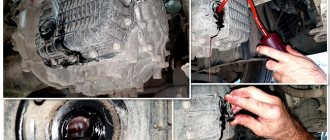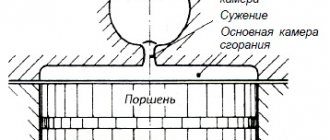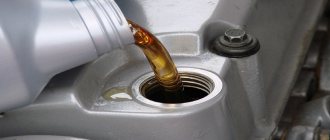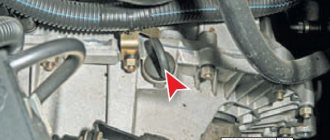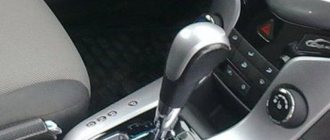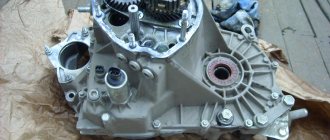The design of cars is constantly being modernized. Today there are many complex but effective structures and functional units that require special care. The transmission or system that allows you to change gears in a car is a special unit that requires attention from the vehicle owner.
As a mechanic, I have encountered many problems arising in the gearbox. One of the most unpleasant breakdowns can be called oil overflow. Beginners often have no idea what the risk of such a breakdown is. In this article I would like to talk about why the oil level in an automatic transmission should not be higher than normal and what consequences an overflow of lubricant can have.
How much lubricant should be poured into the automatic transmission?
You should not check what will happen if you pour oil into the automatic transmission. This can lead to irreversible consequences, and therefore to major repairs. Information about the exact volume of lubricant that needs to be poured into the desired vehicle is specified in the instructions for the vehicle. Much depends on the structural features of the transport and on the method of replacing the fluid.
On average, an automatic transmission uses up to 6-8 liters of lubricant, and as a top-up, it will be enough to use up to 3 liters. When performing a partial replacement, it is not necessary to drain the old lubricant in full. It is enough to add liquid and make sure that the level meets the standards.
Why is the level exceeded?
Everything is obvious here. The reason for the overflow lies in the person who changed the oil in the automatic transmission. Moreover, this can happen not only to beginners, but also to experienced specialists. The latter, relying on their seniority and experience, sometimes ignore the basic rules, believing that they will do everything at the highest level simply by eye.
As a result, the lubricant is higher or lower than the required level. And overfilling and underfilling are equally dangerous for the operation and condition of the automatic transmission.
Before adding fresh lubricant, you need to drain the remaining old fluid. There are recommendations on the volume of ATF lubricant to be filled. Car owners obediently comply with these requirements. Only before this they forget to fully wait for the old oil to drain. As a result, it turns out that more liquid gets inside than was previously drained. This difference is reflected in the overflow.
You need to pour oil into the automatic transmission slowly, gradually. This way the liquid is evenly distributed throughout all channels.
There is another possible reason. After draining the waste and filling in new cold oil, the level when checked turns out to be normal. Only one of the properties of a liquid is its expansion when heated. So it turns out that after the automatic transmission warms up, the oil increases in volume, and the level turns out to be higher than normal.
Signs of lubricant overflow in an automatic transmission
A slight oil overflow may not have serious consequences. A slight excess means + 1-1.5 cm above the norm. However, it is also not easy to notice such an excess. Usually, drivers remain unaware that the oil is filled slightly above the norm. The situation is completely different when the lubricant significantly exceeds the permissible level.
The consequences of overfilling can be quite serious, so it is extremely important to take the necessary measures quickly. As the main “symptoms” of lubricant overflow, it is worth noting:
- the pressure in the system begins to increase, as a result of which leaks form and liquid begins to ooze from the seals and from under the dipstick plug;
- the lubricant begins to foam, bubbles appear, which do not reduce the quality characteristics of the lubricant. The density of the composition also becomes significantly less;
- The automatic transmission is unstable. The driver records jerks and jolts during the trip. May be accompanied by noise;
- Heat transfer is disrupted and the box begins to heat up.
Any irregularities in the operation of the automatic transmission may indicate problems associated with the level of lubrication in the system. This can lead to serious damage to the functional unit, which means the driver must immediately respond to such violations.
How to restore normal levels
As soon as a motorist notices that the lubrication level in his automatic transmission is exceeded, he must solve this problem. This can be done by removing excess.
To prevent overfilling of oil in a still working automatic transmission from causing any serious consequences, you need to balance the amount of lubricant, leaving it at the optimal level.
It is a mistake to think that due to overflow, you will now have to remove the crankcase protection again, unscrew the drain plug, replace the container and try to catch the moment when the level reaches the desired value.
There is a much simpler and more effective way to solve this problem. Only for this you will first have to visit the nearest pharmacy.
- To work, you will need a medical syringe of approximately 10 cubic centimeters. Buy a regular dropper at the pharmacy there. All you need is a transparent tube of sufficient length.
- Cut about 70 centimeters from the dropper tube. Be guided by the degree of access to the automatic transmission housing from the engine compartment.
- It is important that the dropper is lower than the liquid level. This will prevent air from being sucked into the system. Otherwise, it may cause slight foaming. Nothing terribly dangerous, but it shouldn't be allowed to happen.
- One end of the dropper tube is inserted into the hole of the dipstick, with which the driver usually checks the level of transmission fluid in the automatic transmission. If there is no such dipstick, which is important for some boxes, then use the oil filler neck.
- Pull the other end of the IV tubing onto the syringe. The needle must first be removed from the latter.
- Now, using the syringe as a pump, gradually begin to pump out the fluid from the automatic transmission crankcase.
After literally taking 1-2 grease samples, be sure to check the level. Some motorists are overly keen on the procedure, which is why, after completing all the manipulations, the oil level in the box is below the required level. And this also threatens with certain consequences.
Reasons for exceeding the oil level in an automatic transmission?
Overflow of lubricant into automatic transmissions in the vast majority of cases is caused by non-compliance with the rules when replacing the substance. The fact is that the liquid must first be allowed to drain as much as possible, and only then the required volume must be added. If this rule is not taken into account, then an excess of the norm will be obvious.
It is recommended to pour new lubricant very carefully and gradually. The substance penetrates and is distributed through the channels, which is why you need to pour it in, and then wait until the composition is evenly distributed in the system.
Another reason for this violation is that the oil increases in volume as it expands. Many drivers forget about this fact, resulting in overflow.
Excess oil in the manual transmission
If there are extraneous sounds in a manual transmission or improper operation of this unit is noticeable, then it is advisable to check the lubricant level. It is also recommended to check and even change the oil when the car has a high mileage and when buying a car second-hand, because it is completely unknown what kind of oil the previous owner used. These tips also apply to motor oil.
It is worth considering that a manual gearbox has a simpler design, and here the oil plays the role of the working fluid. The oil change time in such boxes is much longer. Typically, in manual transmissions, the oil needs to be changed once every 100 thousand kilometers.
The purposes of checking the oil level and changing the oil in a manual transmission are exactly the same as in the case of an automatic transmission. As for the consequences and symptoms of lubricant overflow, they are approximately the same, but oil overflow into a manual transmission is not as bad as overflow into an automatic transmission.
Symptoms:
- The grease foams.
- The pressure in the system increases.
- Excess oil is squeezed out through rubber seals and oil seals. These items may become damaged and require replacement.
- Grease may also leak out of the dipstick hole.
There is nothing difficult in solving the problem of lubricant overflow in a manual transmission. It is necessary to perform the same operation as described above. In general, you need to fill the box with exactly the volume of oil recommended by the manufacturer. However, you don’t need to fill it all at once. First you need to use most of the lubricant, wait 10 minutes, check the level. If it is below the required level, then you need to add a little oil again to the level.
How to check the lubricant level in an automatic transmission?
For the most accurate results when checking the lubrication level in the transmission system, you will need to use a special device - a dipstick. Before checking, it is important to pay attention to the manufacturer's advice on this issue. Most probes have an o and a "HOT" on them. It is important that the lubricant level is between these marks.
It is recommended to check the oil level when the transmission is warm or after starting the engine, after 3-5 minutes. The procedure should be as follows:
- The car must be placed in neutral.
- Remove the dipstick and wipe the dipstick dry. Return the tool to its place.
- Pull out the device and study the data.
- If there is not enough lubricant, then you need to immediately add the substances. When the grease is higher than normal, it is important to remove it as quickly as possible.
After completing the required action, it is necessary to repeat the verification procedure, but the car must travel about 10 km.
Test method
It is precisely because of non-compliance with measurement rules that underfilling/overfilling occurs. Meanwhile, measuring the ATF level is quite easy.
- The measurement is done with the engine and gearbox warmed up to operating temperatures. To do this, you need to drive 10-15 km. It is cold measurements that lead to errors: in an unheated state, the oil has a smaller volume;
- The automatic transmission switches to “P” mode. The motor must continue to run;
- The surfaces around the test hole are cleaned of debris and dust;
- The control dipstick is pulled out, wiped dry and lowered back.
When subsequently pulled out, the oil level should be approximately halfway from add to full. If the mark is higher than the last one, you are in trouble. And before taking measurements, take the trouble to study the manual: in some models there is a viewing window instead of a dipstick, which requires different approaches when checking the level; in a number of cars the selector is set to “N” and not to “P”; and in some cases, the engine must be turned off when checking.
What consequences can overflowing lubricant into an automatic transmission have?
The consequences of such a violation can be very different. The most common problem is poor gear shifting and a malfunction of the gearbox. Other difficulties include:
- failure of friction discs, which indicates that other devices will quickly become unusable;
- increased fuel consumption as lubricant gets into the fuel;
- a malfunction of the cylinders appears when the mixture hits the spark plugs.
It is worth noting that the problem does not always appear immediately. Sometimes, breakdowns begin to appear during further use.
What characteristics should automatic transmission oil have?
For automatic transmissions, it is recommended to use a fluid that has excellent friction characteristics. Fuel for an automatic transmission must ensure efficient transmission of torque to the wheels and removal of heat from the internal elements of the box. As a result, smooth switching of speed modes is noted.
Each individual version of the car has its own transmission fuel replacement period. As a rule, the first need to change it is prescribed at 40,000 km. By this period, there is little oil in the box.
Thus, proper operation and timely maintenance of the automatic transmission helps to avoid breakdowns with this gearbox. The quality of the transmission can be impaired by an insufficient amount of fluid in it. Operating a vehicle with an automatic transmission with a low transmission level leads to rapid breakdown of this device.
How to remove excess lubricant from the system?
A slight overflow is not a big deal, but when the problem may require quick intervention. You can fix the problem yourself by removing the oil filter. The liquid will completely drain from the system, after which it remains to install it in place.
If such actions do not solve the problem, you will have to remove the grease using the “suction” method. For this, a regular dropper and syringe are used. Excess liquid is removed through the dipstick hole. The manipulations are not complicated and do not require a visit to a service station.
How to eliminate overflow?
Depending on the design of the automatic transmission, control over the transmission oil level is carried out in one of several ways:
- plastic sleeve installed at the lowest point of the pallet;
- inspection hole on the side of the box;
- dipstick
In the first two cases, draining excess ATF fluid and adjusting the level is easiest. Before the procedure, read the operating instructions for the car. An important point is the one that indicates the temperature for measuring the oil level in the automatic transmission. It is usually measured on a fully warmed-up box, on a running or stopped engine.
After the box has warmed up to the required temperature, simply unscrew the control plug and allow the excess to drain. When the oil stream becomes thin, screw the plug back on. There is no need to wait for the last drop to fall.
For vehicles equipped with a dipstick, the procedure is somewhat more complicated. You will need a syringe (the maximum volume you can find) and a standard medical dropper. Securely attach the dropper to the syringe so that it does not fall into the well. With the engine stopped, remove the required amount of oil through the dipstick hole. Check the level under the conditions specified by the manufacturer.
As you know, hydromechanical automatic transmissions and variators are units that use not just transmission oil, but a special fluid. This automatic transmission fluid (ATF) differs in properties from analogues for most manual transmissions and robotic gearboxes.
At the same time, many car enthusiasts mistakenly believe that if a low ATF level is dangerous for the gearbox, then it is better to fill the automatic transmission with as much lubricant as possible. Let us note right away that this is not true. Next, we will talk about what a high oil level in an automatic transmission can lead to, the consequences for the unit, as well as how to understand that the oil level is high and how to bring it back to normal.
Read in this article
Useful tips
When checking, the oil level on the dipstick should normally be between the HOT and COLD marks. A shift towards HOT of 2-3 mm is allowed, but not higher. In this case, you need to check the oil only on a well-warmed automatic transmission.
In order for the fluid in the machine to fully heat up to operating temperature, you must drive the car at least 10 km. Then the car should idle for about 5 minutes, after which you should move the selector through the main automatic transmission modes, lingering in each for about 2-3 seconds.
As for the COLD mark, this indicator is a service indicator and is necessary in order to fill the main amount of oil into the unit as part of automatic transmission repair or maintenance. Next, the oil is added a little more, then the box is warmed up, after which the level is further adjusted. It turns out that following the COLD mark and checking the oil level “cold” is a mistake.
It also happens that there is only one mark on the dipstick. So, in this case, you should focus on it. Also an important recommendation (especially for maintenance-free boxes without a dipstick) is the rule to fill in exactly as much oil as was previously drained.
Remember, in an automatic transmission, the torque from the internal combustion engine is transmitted to the transmission through ATF, and the oil in the automatic transmission has unique protective and cleaning properties, retaining dirt, products and deposits.
How to drain excess oil from an automatic transmission
There are several ways to remove excess oil from an automatic transmission. Often, the quickest and easiest way to remove excess oil is with a syringe. To do this, put a thin rubber tube on the syringe (suitable for a dropper), after which it is inserted into the hole for the probe and pumped out.
Everything will depend on the conditions in which the car is located, on its design features, as well as what tools are at hand, whether there is a garage with a pit or a lift, etc. It is important to constantly check the oil level after draining, removing excess from the box in small portions.
You should also drain the oil into a clean container (especially if there is no reserve for topping up). The fact is that usually after draining you have to pour some of the lubricant back in order to set the level correctly.
